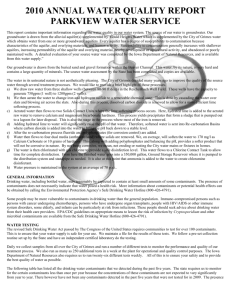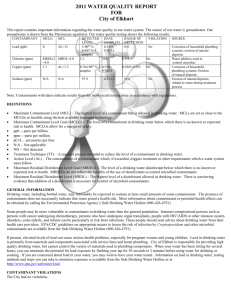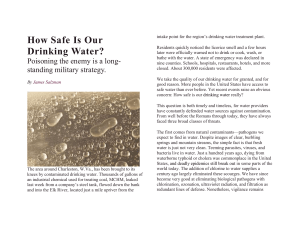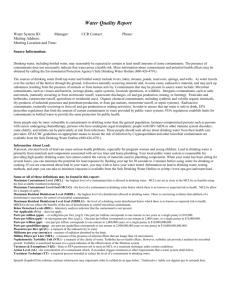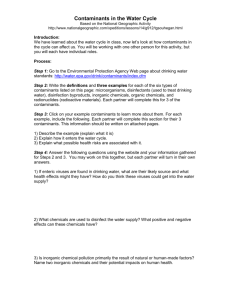406 N Cheyenne Ave
advertisement
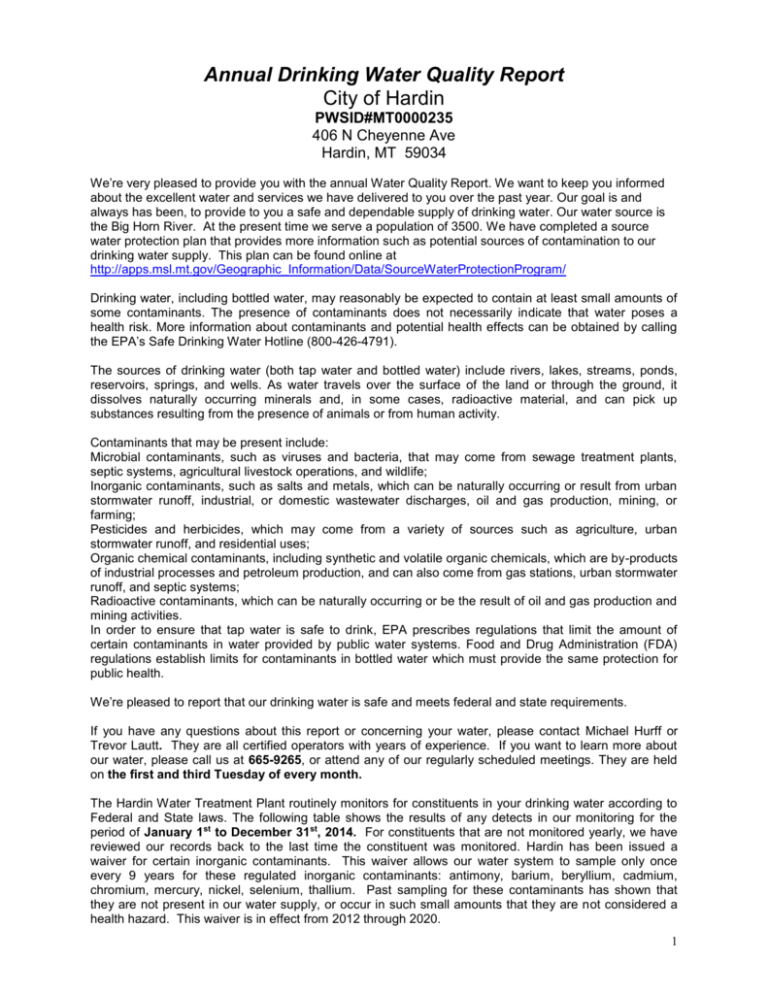
Annual Drinking Water Quality Report City of Hardin PWSID#MT0000235 406 N Cheyenne Ave Hardin, MT 59034 We’re very pleased to provide you with the annual Water Quality Report. We want to keep you informed about the excellent water and services we have delivered to you over the past year. Our goal is and always has been, to provide to you a safe and dependable supply of drinking water. Our water source is the Big Horn River. At the present time we serve a population of 3500. We have completed a source water protection plan that provides more information such as potential sources of contamination to our drinking water supply. This plan can be found online at http://apps.msl.mt.gov/Geographic_Information/Data/SourceWaterProtectionProgram/ Drinking water, including bottled water, may reasonably be expected to contain at least small amounts of some contaminants. The presence of contaminants does not necessarily indicate that water poses a health risk. More information about contaminants and potential health effects can be obtained by calling the EPA’s Safe Drinking Water Hotline (800-426-4791). The sources of drinking water (both tap water and bottled water) include rivers, lakes, streams, ponds, reservoirs, springs, and wells. As water travels over the surface of the land or through the ground, it dissolves naturally occurring minerals and, in some cases, radioactive material, and can pick up substances resulting from the presence of animals or from human activity. Contaminants that may be present include: Microbial contaminants, such as viruses and bacteria, that may come from sewage treatment plants, septic systems, agricultural livestock operations, and wildlife; Inorganic contaminants, such as salts and metals, which can be naturally occurring or result from urban stormwater runoff, industrial, or domestic wastewater discharges, oil and gas production, mining, or farming; Pesticides and herbicides, which may come from a variety of sources such as agriculture, urban stormwater runoff, and residential uses; Organic chemical contaminants, including synthetic and volatile organic chemicals, which are by-products of industrial processes and petroleum production, and can also come from gas stations, urban stormwater runoff, and septic systems; Radioactive contaminants, which can be naturally occurring or be the result of oil and gas production and mining activities. In order to ensure that tap water is safe to drink, EPA prescribes regulations that limit the amount of certain contaminants in water provided by public water systems. Food and Drug Administration (FDA) regulations establish limits for contaminants in bottled water which must provide the same protection for public health. We’re pleased to report that our drinking water is safe and meets federal and state requirements. If you have any questions about this report or concerning your water, please contact Michael Hurff or Trevor Lautt. They are all certified operators with years of experience. If you want to learn more about our water, please call us at 665-9265, or attend any of our regularly scheduled meetings. They are held on the first and third Tuesday of every month. The Hardin Water Treatment Plant routinely monitors for constituents in your drinking water according to Federal and State laws. The following table shows the results of any detects in our monitoring for the period of January 1st to December 31st, 2014. For constituents that are not monitored yearly, we have reviewed our records back to the last time the constituent was monitored. Hardin has been issued a waiver for certain inorganic contaminants. This waiver allows our water system to sample only once every 9 years for these regulated inorganic contaminants: antimony, barium, beryllium, cadmium, chromium, mercury, nickel, selenium, thallium. Past sampling for these contaminants has shown that they are not present in our water supply, or occur in such small amounts that they are not considered a health hazard. This waiver is in effect from 2012 through 2020. 1 We have monitored for lead and copper, and all of our samples have been in compliance with the Lead and Copper Rule. If present, elevated levels of lead can cause serious health problems, especially for pregnant women and young children. Lead in drinking water is primarily from materials and components associated with service lines and home plumbing. Hardin WTP is responsible for providing high quality drinking water, but cannot control the variety of materials used in plumbing components. When your water has been sitting for several hours, you can minimize the potential for lead exposure by flushing your tap for 30 seconds to 2 minutes before using water for drinking or cooking. If you are concerned about lead in your water, you may wish to have your water tested. Information on lead in drinking water, testing methods, and steps you can take to minimize exposure is available from the Safe Drinking Water Hotline or at http://www.epa.gov/safewater/lead. Parameter Copper Date 7/10/13 90th % value 0.074 Units ppm Action level 1.3 Source of Contamination Household plumbing In the tables above and below you will find many terms and abbreviations you might not be familiar with. To help you better understand these terms we've provided the following definitions: Parts per billion (ppb) or Micrograms per liter (ug/l) - one part per billion corresponds to one minute in 2000 years or a single penny in $10,000,00. Parts per million (ppm) or Milligrams per liter (mg/l) - one part per million corresponds to one minute in two years or a single penny in $10,000. Action Level - the concentration of a contaminant which, if exceeded, triggers treatment or other requirements which a water system must follow. Treatment Technique (TT) - (mandatory language) A treatment technique is a required process intended to reduce the level of a contaminant in drinking water. Maximum Contaminant Level - (mandatory language) The “Maximum Allowed” (MCL) is the highest level of a contaminant that is allowed in drinking water. MCLs are set as close to the MCLGs as feasible using the best available treatment technology. Maximum Contaminant Level Goal - (mandatory language) The “Goal”(MCLG) is the level of a contaminant in drinking water below which there is no known or expected risk to health. MCLGs allow for a margin of safety. Nephelometric Turbidity Unit (NTU)-nephelometric turbidity unit is a measure of the clarity of water. Turbidity in excess of 5 NTU is just noticeable to the average person. Picocuries per liter (pCi/L)-picocuries per liter is a measure of the radioactivity in water. Our system had one violation. We failed to provide the results of lead tap water monitoring to the consumers at the location water was tested. These were supposed to be provided no later than 30 days after learning the results. We’re proud that your drinking water meets or exceeds all Federal and State requirements. We have learned through our monitoring and testing that some constituents have been detected. The EPA has determined that your water IS SAFE at these levels. MCL’s are set at very stringent levels. To understand the possible health effects described for many regulated constituents, a person would have to drink 2 liters of water every day at the MCL level for a lifetime to have a one-in-a-million chance of having the described health effect. Some people may be more vulnerable to contaminants in drinking water than the general population. Immuno-compromised persons such as persons with cancer undergoing chemotherapy, persons who have undergone organ transplants, people with HIV/AIDS or other immune system disorders, some elderly, and infants can be particularly at risk from infections. These people should seek advice about drinking water from their health care providers. EPA/CDC guidelines on appropriate means to lessen the risk of infection by cryptosporidium and other microbiological contaminants are available from the Safe Drinking Water Hotline (800-426-4791). 2 We ask that all our customers help us protect our water sources, which are the heart of our community, our way of life and our children’s future. TEST RESULTS Contaminant Violation Y/N Sample Date Highest Level Detected Range Unit Measure ment MCLG MCL Likely Source of Contamination Inorganic Contaminants Fluoride N 10/2/14 0.4 Arsenic N 8/21/14 1 Nitrate + Nitrite as N N 8/21/14 0.13 0.3 0.6 na ppm 4 4 Erosion of natural deposits ppb 0 10 Erosion of natural deposits 0.13 0.13 ppm 10 10 Runoff from fertilizer use; leaching from septic tanks, sewage; erosion of natural deposits 0 80 0 60 By-product of drinking water chlorination By-product of drinking water chlorination pCi/L 0 15 Erosion of natural deposits ppb 0 30 Erosion of natural deposits Unit Measure ment MCLG MCL Likely Source of Contamination ntu na TT Soil Runoff Disinfection By-products Total Trihalomethanes TTHMs Haloacetic Acids HAAs N 8/21/14 30 N 22 ppb 33 8/21/14 30 26 ppb 28 Radioactive Contaminants Gross Alpha N 8/15/11 4.4 Uranium N 8/15/11 2 3.0 4.4 2 2 Test Results Parameter Violation Y/N Sample Date Highest Level Detected Turbidity N 3/9/14 0.221 Lowest monthly % of samples meeting limit 100% FOR ALL MONTHS 3




